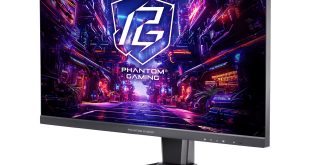To test today, we are using a LaCie calibration gun along with specific software to accurately measure the readings. We analyse the 2D elements of the monitor via this test system featuring a reference Nvidia GTX780 Ti graphics card.
We disabled the DPS (Dynamic Power Saver) mode as this adjusts the screen brightness in direct relation to the surrounding lightning conditions.
We measured Gamut out of the box and the AOC G2460PQU returned a reading of 2.17 which is satisfactory. We manually adjusted the gamma to 1.8 and the panel returned a 1.77 result.
Colour response is reasonably good, although the panel falls short of an IPS screen. We recorded a slight blue bias and the accuracy of the results across the grey scale were slightly out. Lowering the blue setting does somewhat resolve the issue, although we felt the colour balance was never completely accurate. Panel linearity rated average although this would not be critical for fast action gaming.
Text focus is sharp and the backlighting was consistent in the middle area of the screen, falling off at the edges.

Black Definition is good in the middle of the screen although there was some noticeable fluctuation at the edges of the panel – shifting to around 20% in the bottom corners. This screen works well from a direct front viewpoint, but at off angle there is shift, easily seen with solid colours. That said when gaming, it was quite difficult to notice the offshift at the edges.
We also watched some sci fi films on the AOC screen and it was generally quite good, although we could notice the blacks weren't quite as rich as we would have liked with certain space scenes. Contrast levels are excellent however (rated 80,000,000:1), rating around 370 cd/m² with our equipment.

White purity is below average and achieving a very pure bright image was difficult. Panel fluctuation rated between 10% in the center of the screen area and 20% at the edges. This is not that noticeable under most situations, although graphic designers and photo editors will want to target a more expensive screen to get truly acceptable and accurate results.
Panel uniformity is reasonably good with some distortion closer to the sides. Viewing angles are pretty much what we would expect from a TN screen around 168 degrees according to our results, falling short of the best IPS screens we have reviewed in the last year. Gradients were reproduced with only minimal banding evident.
So far we can see that this panel is not an ideal choice for a designer who needs accurate colour reproduction, but it is designed primarily as a gaming screen. The 144hz refresh rate is meant to improve the quality of moving images, particularly when gaming. In theory, the higher the rating the ‘smoother' the screen should look. It is worth pointing out that this panel has no 3D support.
We noticed no ghosting or artifacting from the screen when gaming and passed it over to a clan that we sponsor, for a days ‘game testing'. All the members of the clan gave the screen a 100% positive thumbs up, with several of them commenting on how they ‘liked the smoothness in first person shooters'. Clearly the high refresh rate does appeal to the hard core gamers who demand smooth image movement.

Another efficient 24 inch screen, demanding 30 watts when gaming. In power saving mode, we measured 0.8 watts at the socket.
 KitGuru KitGuru.net – Tech News | Hardware News | Hardware Reviews | IOS | Mobile | Gaming | Graphics Cards
KitGuru KitGuru.net – Tech News | Hardware News | Hardware Reviews | IOS | Mobile | Gaming | Graphics Cards


